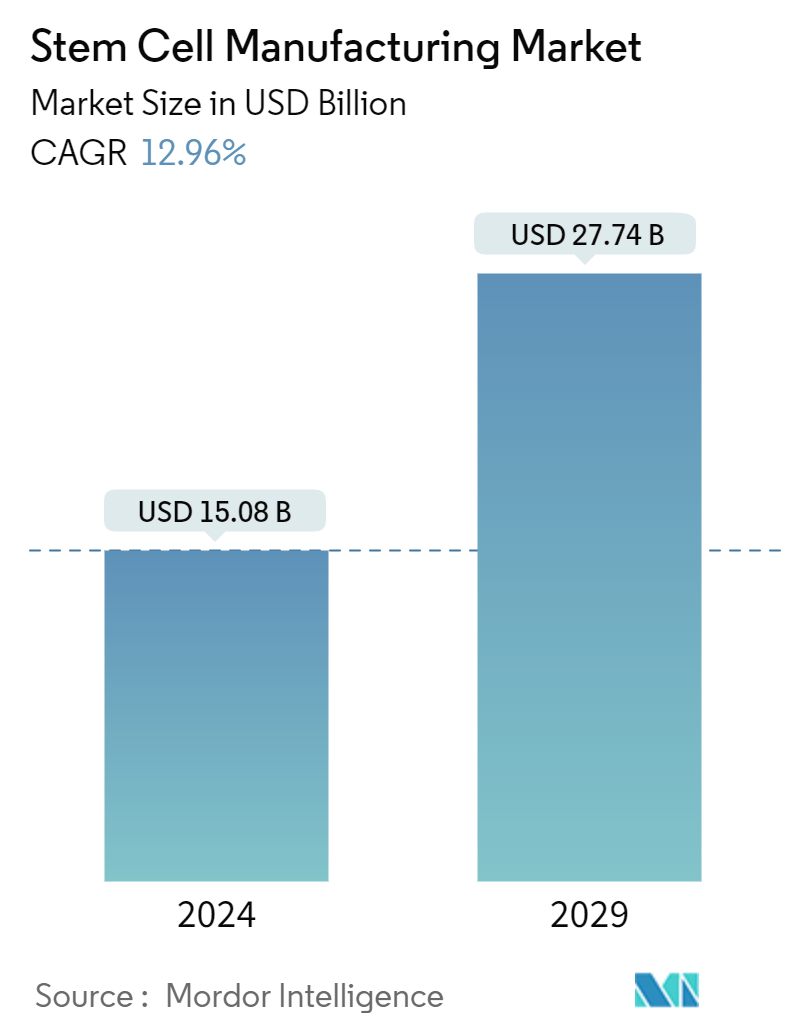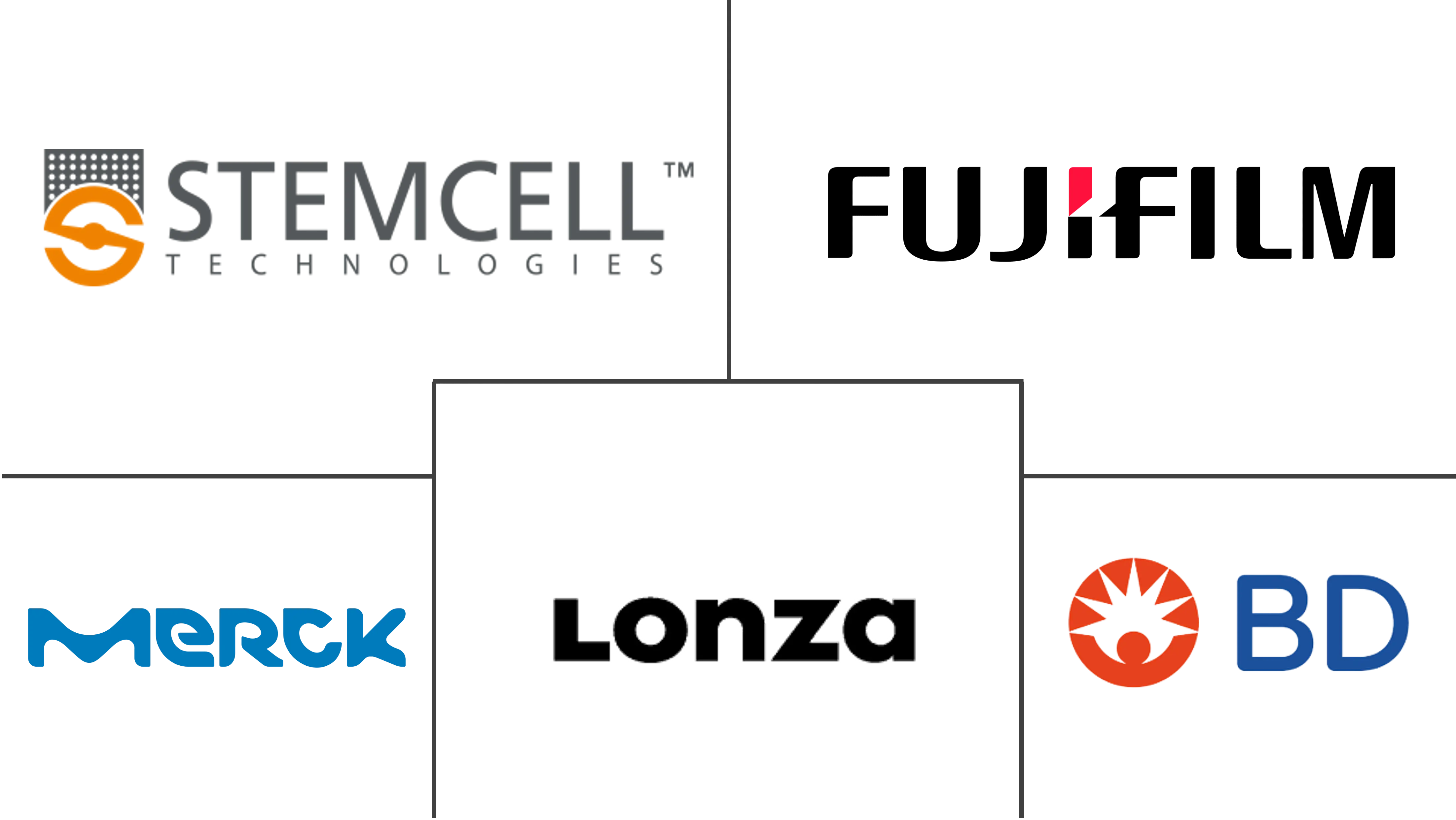Market Size of Stem Cell Manufacturing Industry

| Study Period | 2019 - 2029 |
| Market Size (2024) | USD 15.08 Billion |
| Market Size (2029) | USD 27.74 Billion |
| CAGR (2024 - 2029) | 12.96 % |
| Fastest Growing Market | Asia Pacific |
| Largest Market | North America |
Major Players
*Disclaimer: Major Players sorted in no particular order |
Stem Cell Manufacturing Market Analysis
The Stem Cell Manufacturing Market size is estimated at USD 15.08 billion in 2024, and is expected to reach USD 27.74 billion by 2029, growing at a CAGR of 12.96% during the forecast period (2024-2029).
The COVID-19 pandemic had significantly impacted the stem cell manufacturing market compared to other markets as stem cell-based therapies were suggested to treat COVID-19. Several companies and universities are involved in research studies associated with stem cells. For instance, as per the article published in January 2022 in BMC journal, stem cell therapy and stem cell-derived organoid models received greater emphasis as a new treatment and research method for COVID-19. To better understand the process of SARS-CoV-2 cardiomyocyte-specific infection, several researchers used human induced pluripotent stem cell-derived cardiomyocytes (hiPSC CMS) as a model. In the current scenario, stem cell manufacturing gained a lot more attention due to the wide applications such as pluripotent stem cells used to treat disease forming the basis for future regenerative medicine using stem cells. Due to the surge in technological developments in stem cell synthesis and preservation, it is also projected that the market for stem cell manufacturing is likely to expand in the coming years.
The major factors attributing to the market's growth include the technological advancements in stem cell manufacturing and preservation and growing public awareness about the therapeutic potency of stem cell products. For instance, as per the article published in September 2022 in PubMed, stem cell therapy involving in vitro and in vivo studies is shown to be safe and efficacious in treating various diseases. As per the same source, stem cell treatment seeks to restore or repair damaged organs and congenital malformations using human stem cells such as embryonic stem cells (ESCs), adult stem cells (ASCs), and induced pluripotent stem cells (iPSCs).
Further, product launches, company expansion, and research center launches are anticipated to drive the growth of the market over the forecast period. For instance, in September 2021, STEMCELL Technologies launched human pluripotent stem cell (hPSC) characterization and banking services in partnership with WiCell, making it easier for pluripotent stem cell researchers to achieve critical yet often overlooked steps. Additionally, in October 2022, COST Association celebrated Stem Cell Awareness Day highlighting a network of researchers working to foster a greater understanding of stem cell research and potential applications for millions of people suffering from incurable diseases and injuries.
Thus, the rise in research studies of stem cell therapy, the increase in product launches, and the surge in awareness regarding the importance of stem cell therapy drive the growth of the market over the forecast period. However, the popularity of alternative procedures is a major drawback for the market.
Stem Cell Manufacturing Industry Segmentation
As per the scope of the report, a stem cell is a cell with the unique ability to develop into particular cell types in the body. In the future, they may be used to replace cells and tissues that have been damaged or lost due to disease. The Stem Cell Manufacturing Market is Segmented by Type (Products (Culture Media, Consumables, Instruments, Stem Cell Lines and Services), Application (Stem Cell Therapy, Drug Discovery and Development, and Stem Cell Banking), End User (Pharmaceutical and Biotechnology Companies, Cell Banks and Tissue Banks, and Other End Users), and Geography (North America, Europe, Asia-Pacific, Middle East and Africa, and South America). The market report also covers the estimated market sizes and trends for 17 countries across major regions globally. The report offers the value (in USD million) for the above segments.
| By Type | ||||||
| ||||||
| Services |
| By Application | |
| Stem Cell Therapy | |
| Drug Discovery and Development | |
| Stem Cell Banking |
| By End User | |
| Pharmaceutical and Biotechnology Companies | |
| Cell Banks and Tissue Banks | |
| Other End Users |
| Geography | ||||||||
| ||||||||
| ||||||||
| ||||||||
| ||||||||
|
Stem Cell Manufacturing Market Size Summary
The stem cell manufacturing market is poised for significant growth, driven by advancements in technology and increasing public awareness of the therapeutic potential of stem cell products. The market has gained considerable attention due to its applications in regenerative medicine, with pluripotent stem cells being utilized to treat various diseases. The COVID-19 pandemic further accelerated interest in stem cell-based therapies, as researchers explored their potential in treating the virus. The market is characterized by a surge in research studies, product launches, and the establishment of stem cell banks, which are expected to contribute to its expansion over the forecast period. Despite the promising growth prospects, the market faces challenges from the popularity of alternative procedures.
North America is anticipated to maintain a significant share of the stem cell manufacturing market, supported by a robust research infrastructure, public-private funding, and a high concentration of key players and research activities. The region's market growth is further bolstered by strategic initiatives and partnerships aimed at advancing stem cell therapy applications. The competitive landscape of the market includes major players such as Becton, Dickinson and Company, Fujifilm Holdings Corporation, and Lonza Group, among others. These companies are actively involved in expanding their capabilities and offerings, as evidenced by recent expansions and funding activities. Overall, the market is expected to experience substantial growth, driven by technological advancements, increased research activities, and supportive regulatory frameworks.
Stem Cell Manufacturing Market Size - Table of Contents
-
1. MARKET DYNAMICS
-
1.1 Market Overview
-
1.2 Market Drivers
-
1.2.1 Technological Advancements in Stem Cell Manufacturing and Preservation
-
1.2.2 Growing Public Awareness About the Therapeutic Potency of Stem Cell Products
-
1.2.3 Growing Public-Private Investments and Funding in Stem Cell-based Research
-
-
1.3 Market Restraints
-
1.3.1 High Operational Costs Associated with Stem Cell Manufacturing and Banking
-
-
1.4 Porter's Five Forces Analysis
-
1.4.1 Threat of New Entrants
-
1.4.2 Bargaining Power of Buyers/Consumers
-
1.4.3 Bargaining Power of Suppliers
-
1.4.4 Threat of Substitute Products
-
1.4.5 Intensity of Competitive Rivalry
-
-
-
2. MARKET SEGMENTATION (Market Size by Value - USD million)
-
2.1 By Type
-
2.1.1 Product
-
2.1.1.1 Culture Media
-
2.1.1.2 Consumables
-
2.1.1.3 Instruments
-
2.1.1.4 Stem Cell Lines
-
-
2.1.2 Services
-
-
2.2 By Application
-
2.2.1 Stem Cell Therapy
-
2.2.2 Drug Discovery and Development
-
2.2.3 Stem Cell Banking
-
-
2.3 By End User
-
2.3.1 Pharmaceutical and Biotechnology Companies
-
2.3.2 Cell Banks and Tissue Banks
-
2.3.3 Other End Users
-
-
2.4 Geography
-
2.4.1 North America
-
2.4.1.1 United States
-
2.4.1.2 Canada
-
2.4.1.3 Mexico
-
-
2.4.2 Europe
-
2.4.2.1 Germany
-
2.4.2.2 United Kingdom
-
2.4.2.3 France
-
2.4.2.4 Italy
-
2.4.2.5 Spain
-
2.4.2.6 Rest of Europe
-
-
2.4.3 Asia-Pacific
-
2.4.3.1 China
-
2.4.3.2 Japan
-
2.4.3.3 India
-
2.4.3.4 Australia
-
2.4.3.5 South Korea
-
2.4.3.6 Rest of Asia-Pacific
-
-
2.4.4 Middle East and Africa
-
2.4.4.1 GCC
-
2.4.4.2 South Africa
-
2.4.4.3 Rest of Middle East and Africa
-
-
2.4.5 South America
-
2.4.5.1 Brazil
-
2.4.5.2 Argentina
-
2.4.5.3 Rest of South America
-
-
-
Stem Cell Manufacturing Market Size FAQs
How big is the Stem Cell Manufacturing Market?
The Stem Cell Manufacturing Market size is expected to reach USD 15.08 billion in 2024 and grow at a CAGR of 12.96% to reach USD 27.74 billion by 2029.
What is the current Stem Cell Manufacturing Market size?
In 2024, the Stem Cell Manufacturing Market size is expected to reach USD 15.08 billion.

